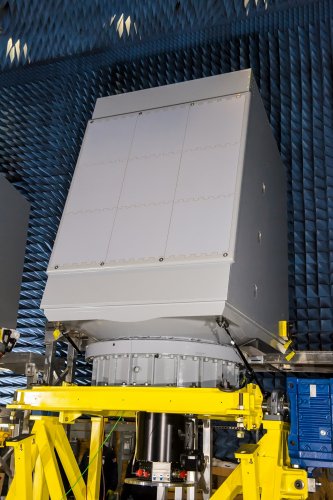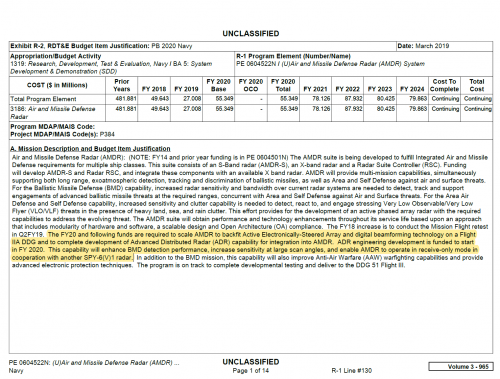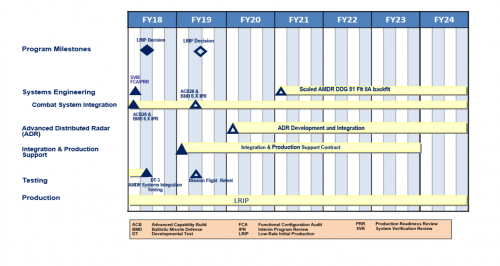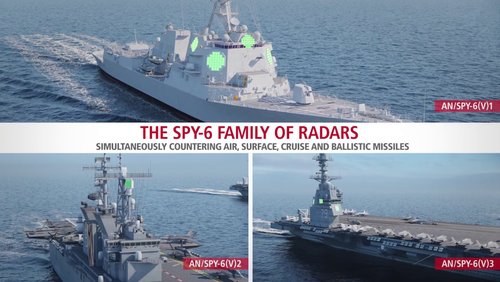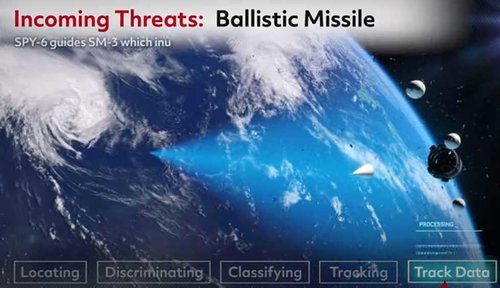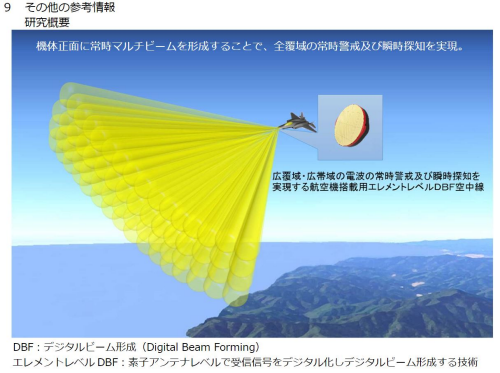The Navy is confronting a welcome challenge -- what to do with a new radar that is three times better than expected. Government testers recently completed developmental evaluation of the SPY-6(V)1 radar and concluded the new, Raytheon-built sensor is nearly 100 times more sensitive than the legacy SPY-1 radar, built by Lockheed Martin.
This previously unreported determination has implications not only for the reach of the SPY-6(V)1 sensor slated for the Navy's new Flight III Arleigh Burke-class destroyers, but also for a new initiative to swap out for SPY-1 radar from the Flight IIA fleet with a scaled-down variant of the SPY-6(V)1 and a vision to potentially create a distributed radar network across the surface fleet for improved ballistic missile defense.
The Air and Missile Defense Radar program set a requirement for the SPY-6(V)1 sensor to be 30 times more sensitive than the SPY-1. The Navy has validated that the new sensor has a decibel measurement of “+20dB” compared to the legacy radar, according to a Raytheon document approved by the Navy for public release.
“SPY-6(V)1 is approximately 20dB more sensitive than SPY-1 -- nearly 100 times -- which translates to more than three times the original requirement,” said Scott Spence, director of naval radar systems, told
Inside Defense. “SPY-6 also delivers a significant increase in range to the legacy radar.”
Spence declined to provide specifics on the increased range.
In January, the Air and Missile Defense Radar program executed the
last of 15 developmental tests for the $5.8 billion program to develop and deliver a larger and more powerful sensor for the Navy's Flight III DDG-51 destroyers.
Curt von Braun, technical director of Raytheon's Seapower Capability Systems, said the company -- since being selected by the Navy in October 2013 to develop the SPY-6 -- has touted plans to deliver a new radar that would be 30 times more sensitive.
“The 30 was an original number, but [during] the test period out at Pacific Missile Range Facility, we've been realizing additional sensitivity through our design margins that have been now tested,” von Braun said, referring to the Defense Department test range in Hawaii. “So we're more at liberty to advertise the better performance than was designed in the margins and now those are being officially realized by the radar.”
The SPY-6(V)1, being built in a new manufacturing facility in Andover, MA, featuring state-of-the-art robotics and automation tools, is composed of 37 radar modular assemblies -- each a two-foot cube -- that can be scaled to fit a smaller or larger need.
The Navy is acquiring a variant with nine RMAs called the Enterprise Air Surveillance Radar for its new large-deck amphibious assault ships, amphibious transport dock ships, the new frigates and aircraft carriers.
Raytheon officials, who believe the RMAs could be stacked by the scores or hundreds for homeland defense purposes, are hoping the Navy will adopt a 24-RMA configured sensor as part of a new radar upgrade -- potentially for the bulk of its DDG-51 Arleigh Burke destroyer class -- that would give the Flight IIA variant a radar that would be 30 times more sensitive than the SPY-1.
“The Navy wants to make sure those older ships can be in the modern fight,” said von Braun. “And the modern fight is more complex than it was in the day when the SPY-1 radar was built. And so the Navy is keenly interested in this backfit opportunity.”
The Navy has approved for public release a Raytheon document describing a 24-RMA version of a scaled-down SPY-6 for the proposed DDG-51 backfit as being “+15dB” compared to the SPY-1. von Braun said this means the scaled-down version would deliver the Navy a radar 30 times more sensitive than the SPY-1, effectively providing the capability the Navy originally desired from the SPY-6.
The 24 RMA-configured radar for the DDG-51 Flight IIA ships can deliver a capability “that is identical to the original requirement that we had for the SPY-6 on the forward fit,” said Spence. “So, we will perform to the requirement of the forward fit, but on the smaller version of the backfit.”
The Navy's FY-20 budget request seeks $55.3 million as part of a $381 million plan through FY-24 to scale the AMDR radar down to fit into the Flight IIA ships. The Navy has 46 Flight IIA destroyers, according to a Congressional Research Service report, including DDG-79 through DDG-124 plus DDG-127.
Were the Navy to swap out the SPY-1 of all Flight IIAs, such a project could be worth hundreds of millions of dollars, possibly billions.
The implied acquisition strategy in the budget suggests this backfit program is part of the AMDR program and provides no indication the Navy intends to compete the project, which would likely interest -- at the very least -- Lockheed Martin.
“Lockheed Martin is supporting the U.S. Navy customer in their radar roadmap, which includes both SPY-1 and SPY-6 evolution,” JoAnn Grbach, a Lockheed Martin spokeswoman, said.
The Navy's FY-20 budget request seeks funding “to scale AMDR to backfit active electronically-steered array and digital beam-forming technology on a [Flight] IIA DDG and to complete development and integrate Advanced Distributed Radar (ADR) capability into AMDR.”
The AMDR capability, according to the Navy, will enhance ballistic missile defense detection performance, “increase sensitivity at large scan angles, and insert the core algorithms to enable AMDR to operate in receive-only mode, in cooperation with other radars.”
The new capability will also improve anti-air warfare capabilities and provide advanced electronic protection techniques, according to the budget.
In FY-17, the Navy pivoted to procuring Flight III variants, which incorporate engineering and design changes -- including increased power and cooling -- to accommodate the larger SPY-6 radar. The Navy plans to buy 22 Flight III ships.
“SPY-6 will give the U.S. Navy the operational flexibility to perform missions in ways never before possible,” according to Spence. “Unlike the radar it will replace, SPY-6 is a digital active electronically scanned array radar. This fundamentally changes how it interacts with a combat management system,” he said, referring to the Lockheed-built Aegis combat weapon system which the SPY-1 works with.
SPY-6 is combat-system agnostic, he said, so it can pair with all Navy systems such as the Raytheon-built Ship Self-Defense System used on some aircraft carriers and large amphibious assault ships as well as combat systems used by allies.
The new AMDR radar, Spence said, “offloads many radar-specific functions that currently need to be performed by the Aegis combat system, allowing the combat management system to do its job without having to spend computing power managing radar assets.”
In addition, the SPY-6 provides increased coverage, allowing “early and accurate threat detection” so the Navy can take advantage of the full range and speed of the newest interceptors paired with the Aegis system, including the Standard-Missile 3 and the SM-6, Spence added.

